My Search for a Soft Loaf for Allergy Daughter
It’s been months since I’ve been on the look out for a soft loaf for allergy daughter. The answer to a very soft crumb is usually a dough enriched with either dairy or soya flour, neither of which my daughter can have.
I’ve been reading about the water roux method also referred to as Tangzhong starter where you cook part of the flour and water first before incorporating that into the rest of the ingredients. This gelatinisation allows you to increase the water content of the dough, makes the crumb very soft and it’s supposed to keep better. Most of the recipes for water roux also have milk powder in them but if you search hard enough you can find ones without. I’ve also read bloggers saying to incorporate the Tangzhong starter into your normal loaf. So far I’ve stayed away from experimenting with the water roux method only because it’s very different from anything I’ve done and in my mind requires a peaceful day without interruptions to give it a go.
I think it was Joanna who first sent me the link to Dan’s Soft Baps but they contain cornflour (cornstarch) which allergy daughter is intolerant to. I tried arrow root to replace it and worked fine and then Dan suggested potato flour, harder to come by where I live but available in health food shops. I can not remember now what the difference was between arrow root and potato flour but nothing significant that I recall, but this is only in the context of making the recipe as rolls.
I have two problems with allergy daughter and bread, firstly she loves soft crumb so much she would be happier eating the ready-sliced supermarket white loaves. It speaks volumes about my homemade loaf doesn’t it? It’s ok I take no notice…you get used to your kids’ insults. The second problem is she loves toasted bagels in the morning. She can only eat some bagels from some shops and out of those she can eat we have to cut a bit off the bottom because they contain maize grits. I’ll just say now…there is no way I’m going to make bagels on a regular basis, even if I perfected my half-arse attempts so far.
This is how Dan’s soft baps became a loaf which makes good toast. I started making a few trials of rolls adapting the recipe for her, as well as the change of cornflour (cornstarch) I experimented using lard or her dairy-free butter, both worked successfully not just for her but for the rest of us. I decreased the amount of sugar from 50 grms to 40 grms, that was sufficient for a household who doesn’t add sugar to bread and I turned this recipe into a loaf.
From the very first loaf I realised it made great toast. It was a perfect slightly sweeten alternative to replace the bagels for allergy daughter but it’s more than that it makes good toast with no knowledge it’s a special loaf, they all loved it.
Potato Flour
Ever since Dan suggested I use potato flour I’ve been using up my stock of it and therefore my experience with the toast is only using the potato flour. The reason I want to single out the potato flour is because after having a discussion on Mamta’s forum with a member there about the merits of potato flour I was given the impression the potato flour may be of significance. They suggested potato flour is good to coat chips prior to frying, and using it in mincemeat because of its mallard reaction. It has a gelling point of 60C, it doesn’t char as wheat flour because low protein. I haven’t looked into it in the usual sources and therefore can’t advise, but it has left me wondering if the tastiness of this toast is in part to do with the potato flour.
The only way to find out is to make two loaves. What I can advise is not to increase the potato content above the 26-28grms, I once went as high as 40 grms and it didn’t work, it retained too much moisture.
Texture
The way I make it here it produces a very soft crumb and if you want a chewier crumb then follow Dan’s original method of making a 3 hour sponge first, I talk about the difference between the two here.
Milk Substitute
Obviously use milk if you have no problems with it but I’ve used oat milk and rice milk with equal success.
Wet Dough
The quantities below give you a pretty wet dough and the best way I handle it is using a lightly oiled board and using your fingertips to pull the dough, giving it a necessary stretch for the top of it. I find it easier with clean hands that are just slightly wet so after turning out the dough from the bowl on to the oiled board I wash my hands but don’t dry them, easier to pick up the dough.
The other option is to cut back on the water by 50 grms. You don’t have to handle the dough too much, once it’s done its first rise and you’ve taken it out onto the oiled board your shaping it by stretching until the top is taught and it’s long enough to fit in the tin.
Dan’s Soft Baps Adapted for a Loaf
You’ll need at least a 3lb long tin like I use and the dough will rise quite a bit above but I like the look of it
- 800 grms strong bread flour
- 26 grms of potato flour
- 15 grms of fine salt
- 40 grms white sugar
- 1 sachet of easy-blend yeast (7 grms)
- 450 grms water – make sure it’s warm
- 75 grms milk (or rice/oat milk)
- 75 grms butter (or dairy-free butter or lard or veg shortening)
When ready to bake pre-heat oven to 220C / fan 200C / 425F / gas 7 bake for 40 minutes
Mix first the flour, potato flour, salt, sugar, yeast together. Add the water.
Melt the butter and add the milk cold to it, this makes sure the temperature of the butter cools down before adding to the flour, just put your finger in it to double check it’s just warm and not hot. Mix it all in well, you should have a sticky dough.
Cover it and leave it at room temperature between 2-3 hours until well risen. I made the big mistake once of wanting to speed things up by putting it too near the radiator and killed the yeast…had nice dense rolls with no oven spring.
Below is taken after just over an hour and you can see it’s rising well.
Once it’s risen, lightly oil a board turn the dough on to it and start pulling the edges of the dough into the middle, it should be sticky enough to stay put. Keep shaping this way, you’re trying to shape it by stretching it.
By the way…bread dough is not fragile and will stand lots of manhandling. You need to give what it’s going to be its top side a nice stretch. Once you’ve done that pick it up and turn it over. It’s floppy but just do it with some assurance, it will be fine.
Put it in your tin and leave it to rise for another 30-40 minutes or so it should be coming just over the brim of the tin.
Pre-heat the oven for a good 15-20 minutes before you’re ready to bake and put it in. Put the loaf in and turn down the temperature by 10 degrees. I don’t add steam. I find baking it this way gives it a thinner crust which my daughter prefers.



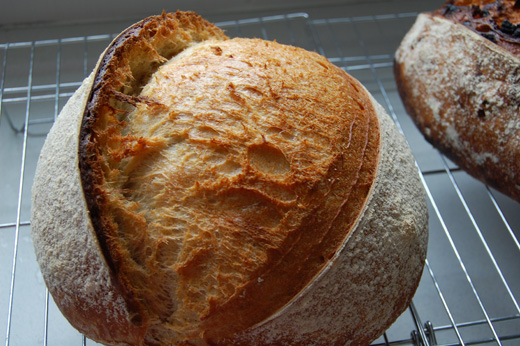

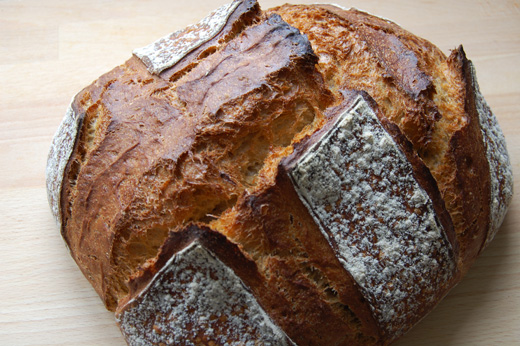



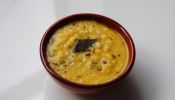


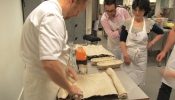














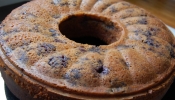


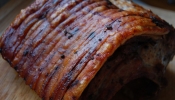

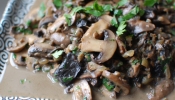

{ 8 comments… read them below or add one }
Those toast pictures are making me drool! It looks like a beautiful loaf.
thanks foodycat.
Beautiful toast – a great way to convert those addicted to shop bread
Interesting stuff about the potato flour – one of Nigella’s tips in Domestic Goddess is to save potato boiling water for baking bread, or to use some instant mash powder in water to produce a softer crumb – sounds like it could be providing potato starch in a different way. Perhaps something to try when potato flour is hard to come by?
Will have to give this loaf a go soon…
hi Louise – I’m going to make a note on the recipe after baking the loaf again this afternoon. I used about 3 different bread flours depending what shop I’m in and today was the strongest I can get which is 15% protein, the waitrose Canadian strong flour and the others are around 12-13%, what I noticed this afternoon was with the Canadian flour the dough wasn’t as sticky as with using the other flours and I could have folded into shape easily without putting any oil on the board, just a sprinkle of flour would have done the trick. In this case I found the oiling of the board acted too much of a barrier trying to get the dough to stick to itself and hold its shape.
I’ve had potato bread in good restaurants and always my favourite from the rest on offer.
OK Chemical Girl, what exactly is the potato flour/corn starch doing in here? I mean, how is it changing the bread? I often use potato in bread, but I use boiled potato, and sometimes also use the potato water as the liquid in the bread – I know that softens the bread crumb and crust – but using it, and knowing how and why it’s working are two different things.
I don’t know hence my comment about the potato flour may contribute to the “tastiness” of the toast… I do know I’ve eaten one of the most delicious breads in a restaurant made with potato.
It’s a retainer of moisture as it appears from my experience of adding too much potato flour and your experience of softening crumb and crust. I guess comes down to the make up of a potato rather than anything else…potatoes baked are delicious..now you’re making me look up potato in McGee’s book!
I have my head full of tracking down rye flour at the moment and why you should not overmix…will come back to the potato & bread afterwards!
I’m intrigued – I’ve not seen that method for handling a wet dough before and I can’t wait to try it out. You just keeping pulling it into the centre from the top edges (it doesn’t look like you did it from the bottom although I’m not good at interpreting pictures at times)?
EM – Have a look at my Walnut Bread recipe and also my How To Make An Easy Loaf post..they have good pics of how I do it.